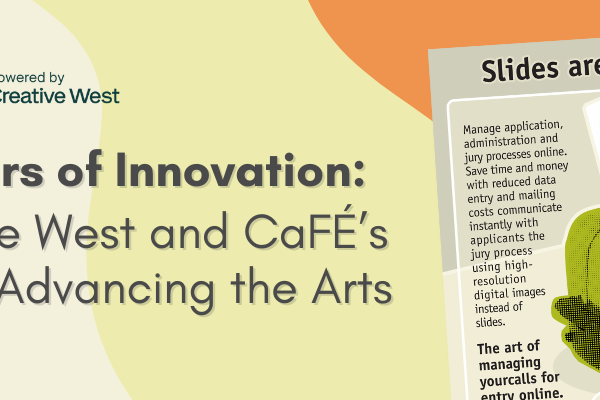
A lot goes into creating a call for entry. No matter the kind of contest you’re putting together—an exhibition, a request for qualifications, a grant application, a studio tour, etc.—the details may differ, but the basic structure of the call is the same. To help you understand what your potential applicants need to know before they apply, we’ve broken down the components of a call for entry into six essential elements.
1. Artist Eligibility: Who can enter the contest?
Can any artist apply, or do they have to be of a certain age? Do they have to live in a certain location? Is your contest only available to members of your organization? These are the questions to ask yourself when outlining the eligibility requirements for the artists applying to your call. Your call description should explicitly state who is eligible to apply—especially if your call for entry is open only to specific types of artists. Below is a list of common eligibility requirements:

- Age restrictions
- Location of the artist
Tip: In CaFÉ, you can select one of the following eligibility criteria: International, National, Regional, Local, or Unspecified. While the regional or local boundaries should be laid out in your call description, artists will be able to search for calls based on this criteria. - Organization-member status
- Demographic eligibility
- Other eligibility requirements (e.g. artist must be a student, must not be a previous winner, etc.)
When you create your call in CaFÉ, be sure to outline your eligibility requirements in your call’s description and legal agreement. We recommend starting off your submission guidelines with this information so artists are aware right off the bat if they are eligible and should therefore keep reading about your call. If your call is open to everyone and there are no eligibility requirements, be sure to mention that as well.
2. Accepted Mediums: What art is accepted?
Not only is it important to outline which artists are eligible to apply to your call, it’s also important to outline which artworks can be submitted. Start by determining which artistic disciplines are accepted (paintings, sculptures, photography, etc.). From there you can further narrow down which media types you will allow (acrylic, metalwork, digital, etc.). Depending on your call type, you may also want to consider size requirements for the artwork or whether the artwork needs to be ready to hang. Here’s a more of a complete list of artwork eligibility requirements:
- Discipline of the artwork (e.g. drawing, painting, sculpture, installation)
- Media (e.g. pastel, oil paint, clay, mixed-media, fiber art)
- Year artwork was created (e.g. artwork completed no more than three years ago)
- Size requirements (e.g. artwork must not exceed 48” in width or 72” in height)
- Framing/hanging requirements (e.g. pieces must be framed and equipped with hanging hardware)
- Digital artwork eligibility (e.g eligibility of video, film, or audio submissions)

3. Entry Process: How are entries submitted?
After you’ve clearly defined for potential applicants whether they’re eligible, the next step is to describe how they will apply to your call. In addition to instructing applicants to log in or create an account on CaFÉ, you’ll want to outline what will be required to complete their application.

This may include the materials (in addition to the images of their artwork) they must prepare before submitting an application. Examples include a resume/CV, artist statement, project proposal documents, etc. The more materials you require artists to submit, the more time they will need to complete their applications. Therefore, it’s best to inform the artist upfront of how much time they will need to submit their entries.
Tip: Expecting many first-time CaFÉ users to apply to your call? Include a link to our help guide, How to Apply to a Call for Entry on CaFÉ, in your call’s guidelines.
4. Judging Criteria: What are the judges looking for?
The next essential element that should be included in your call is the criteria that will be used to evaluate the artists and their artwork. While every selection process will be different, your criteria might include a number of items. Examples of judging criteria include: interpretation of the event’s theme, level of creativity and originality, and the quality of the artwork and artistic skill demonstrated.

Being transparent about the evaluation process will benefit both you and the artists. First, determining the criteria will help your juror(s) more quickly and confidently score the applications and select the submissions that best meet your guidelines. Secondly, sharing the criteria in your call description will help the applicants understand what the juror(s) are looking for, and may even help them decide whether they should spend their entry fee money based on the judging criteria displayed. Overall, the judging criteria helps establish a fair and organized evaluation process for all participants.
5. Selection Process: How are the artists selected and notified?
Transparency regarding the judging criteria is just as important as the transparency of the selection process as a whole, specifically transparency about what happens after the jury’s decisions are made. Information about the selection process should include the maximum number of artists that will be selected (if applicable) and how the applicants will be notified of the results.

We highly encourage you to notify the artists not invited to the events in addition to the artists invited. Not only does the practice demonstrate the professionalism of the organization, it shows that you acknowledge and appreciate all of the artists who used their time and money to apply to your call. You may also consider adding a timeline of the selection process to your call information, detailing when the jury will take place, and when the artists will be notified of the results. Providing artists with information on the selection process ahead of time allows them to make informed decisions about their availability in regard to your exhibition’s timeline.
Tip: CaFÉ makes it easy to email all artists after the jurying ends. View our help guide, Wrap Up Your Call on CaFÉ, to find instructions on how to notify the artists of the jury results.
6. Final Product: What’s in it for the winner(s)?
The final, essential element of an art contest is also the most exciting and is what motivates artists to apply in the first place. This last component includes what the artists and/or winners of the event can look forward to if invited. If you’re hosting an exhibition, you’ll want to include information as to where and when the event is taking place (be sure to mention if the exhibition is being held virtually), and if you are offering any prize money for top artworks. If you’re putting together a public art project, outline what the artist receives in return for their work—stipends, recognition, etc. No matter what you have in store for your selected artists, this is your chance to get the attention of the best artists out there. Don’t be afraid to have a little fun with it.

Conclusion
Although these are just the basic components of a call for entry, they are a good starting point for building out the details you should include to launch your call. Writing out your rules and guidelines in a transparent way that suits your needs will help ensure that artists understand your goals and are encouraged to apply. With these six essential elements, you’re well on your way to running a successful art contest!
Written by Communications Coordinator Justine Chapel




